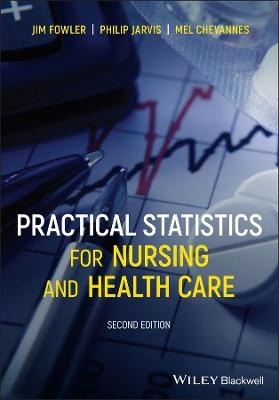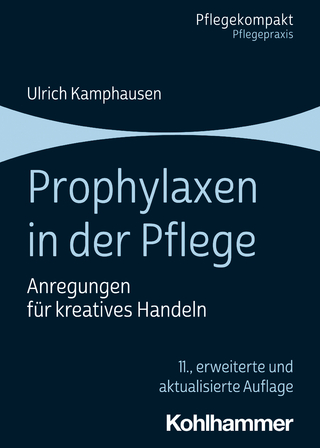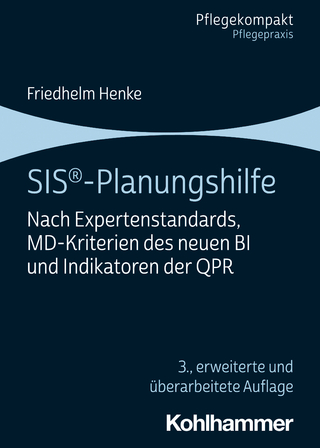
Practical Statistics for Nursing and Health Care
Wiley-Blackwell (Verlag)
978-1-119-69852-4 (ISBN)
The authors explain common methods of interpreting data sets and explore basic statistical principles that enable nurses and health care professionals to decide on suitable treatment, as well as equipping readers with the tools to critically appraise clinical trials and epidemiology journals.
- Offers information on statistics presented in a clear, straightforward manner
- Covers all basic statistical concepts and tests, and includes worked examples, case studies, and data sets
- Provides an understanding of how data collected can be processed for the patients' benefit
- Contains a new section on how to calculate and use percentiles
Written for students, qualified nurses and other healthcare professionals, »Practical Statistics for Nursing and Health Care« is a hands-on guide to gaining rapid proficiency in statistics.
Jim Fowler, former Principal Lecturer, Department of Biological Sciences, De Montfort University, Leicester, UK.
Philip Jarvis, Statistician, Novartis Pharma AG, Basel, Switzerland.
Mel Chevannes, Emeritus Professor of Nursing, University of Wolverhampton, Wolverhampton, UK.
PREFACE xi
FOREWORD TO STUDENTS xv
1 INTRODUCTION 1
1.1 What do we mean by statistics? 1
1.2 Why is statistics necessary? 1
1.3 The limitations of statistics 2
1.4 Performing statistical calculations 2
1.5 The purpose of this text 3
2 HEALTH CARE INVESTIGATIONS: MEASUREMENT AND SAMPLING CONCEPTS 5
2.1 Introduction 5
2.2 Populations, samples and observations 5
2.3 Counting things - the sampling unit 6
2.4 Sampling strategy 7
2.5 Target and study populations 8
2.6 Sample designs 8
2.7 Simple random sampling 9
2.8 Systematic sampling 9
2.9 Stratified sampling 10
2.10 Quota sampling 11
2.11 Cluster sampling 12
2.12 Sampling designs - summary 12
2.13 Statistics and parameters 13
2.14 Descriptive and inferential statistics 13
2.15 Parametric and non-parametric statistics 14
3 PROCESSING DATA 15
3.1 Scales of measurement 15
3.2 The nominal scale 15
3.3 The ordinal scale 16
3.4 The interval scale 17
3.5 The ratio scale 17
3.6 Conversion of interval observations to an ordinal scale 17
3.7 Derived variables 19
3.8 Logarithms 20
3.9 The precision of observations 21
3.10 How precise should we be? 22
3.11 The frequency table 22
3.12 Aggregating frequency classes 24
3.13 Frequency distribution of count observations 26
3.14 Bivariate data 27
4 PRESENTING DATA 29
4.1 Introduction 29
4.2 Dot plot or line plot 29
4.3 Bar graph 30
4.4 Histogram 32
4.5 Frequency polygon and frequency curve 33
4.5 Centiles and growth charts 35
4.7 Scattergram 35
4.8 Circle or pie graph 35
5 CLINICAL TRIALS 39
5.1 Introduction 39
5.2 The nature of clinical trials 39
5.3 Clinical trial designs 40
5.4 Psychological effects and blind trials 41
5.5 Historical controls 42
5.6 Ethical issues 43
5.7 Case study: Leicestershire Electroconvulsive Therapy (ECT) study 43
5.8 Summary 45
6 INTRODUCTION TO EPIDEMIOLOGY 47
6.1 Introduction 47
6.2 Measuring disease 48
6.3 Study designs - cohort studies 50
6.4 Study designs - case-control studies 51
6.5 Cohort or case-control study? 53
6.6 Choice of comparison group 54
6.7 Confounding 55
6.8 Summary 56
7 MEASURING THE AVERAGE 57
7.1 What is an average? 57
7.2 The mean 57
7.3 Calculating the mean of grouped data 59
7.4 The median - a resistant statistic 60
7.5 The median of a frequency distribution 61
7.6 The mode 62
7.7 Relationship between mean, median and mode 64
8 MEASURING VARIABILITY 65
8.1 Variability 65
8.2 The range 65
8.3 The standard deviation 66
8.4 Calculating the standard deviation 67
8.5 Calculating the standard deviation from grouped data 68
8.6 Variance 69
8.7 An alternative formula for calculating the variance and standard deviation 70
8.8 Degrees of freedom 71
8.9 The Coefficient of Variation (CV) 72
9 PROBABILITY AND THE NORMAL CURVE 75
9.1 The meaning of probability 75
9.2 Compound probabilities 76
9.3 Critical probability 78
9.4 Probability distribution 79
9.5 The normal curve 81
9.6 Some properties of the normal curve 82
9.7 Standardizing the normal curve 83
9.8 Two-tailed or one-tailed? 84
9.9 Small samples: the t-distribution 86
9.10 Are our data normally distributed? 88
9.11 Dealing with 'non-normal' data 91
10 HOW GOOD ARE OUR ESTIMATES? 95
10.1 Sampling error 95
10.2 The distribution of a sample mean 95
10.3 The confidence interval of a mean of a large sample 98
10.4 The confidence interval of a mean of a small sample 99
10.5 The difference between the means of two large samples 100
10.6 The difference between the means of two small samples 102
10.7 Estimating a proportion 103
10.8 The finite population correction 105
11 THE BASIS OF STATISTICAL TESTING 107
11.1 Introduction 107
11.2 The experimental hypothesis 107
11.3 The statistical hypothesis 108
11.4 Test statistics 110
11.5 One-tailed and two-tailed tests 110
11.6 Hypothesis testing and the normal curve 111
11.7 Type 1 and type 2 errors 113
11.8 Parametric and non-parametric statistics: some further observations 113
11.9 The power of a test 114
12 ANALYSING FREQUENCIES 115
12.1 The chi-squared test 115
12.2 Calculating the test statistic 115
12.3 A practical example of a test for homogeneous frequencies 118
12.4 One degree of freedom - Yates' correction 119
12.5 Goodness of fit tests 120
12.6 The contingency table - tests for association 121
12.7 The 'rows by columns' (r x c) contingency table 125
12.8 Larger contingency tables 127
12.9 Advice on analysing frequencies 129
13 MEASURING CORRELATIONS 131
13.1 The meaning of correlation 131
13.2 Investigating correlation 131
13.3 The strength and significance of a correlation 133
13.4 The Product Moment Correlation Coefficient 134
13.5 The coefficient of determination r2 136
13.6 The Spearman Rank Correlation Coefficient rs 137
13.7 Advice on measuring correlations 139
14 REGRESSION ANALYSIS 141
14.1 Introduction 141
14.2 Gradients and triangles 142
14.3 Dependent and independent variables 143
14.4 A perfect rectilinear relationship 144
14.5 The line of least squares 146
14.6 Simple linear regression 147
14.7 Fitting the regression line to the scattergram 150
14.8 Regression for estimation 150
14.9 The coefficient of determination in regression 151
14.10 Dealing with curved relationships 152
14.11 How we can 'straighten up' curved relationships? 155
14.12 Advice on using regression analysis 155
15 COMPARING AVERAGES 157
15.1 Introduction 157
15.2 Matched and unmatched observations 158
15.3 The Mann-Whitney U-test for unmatched samples 158
15.4 Advice on using the Mann-Whitney U-test 160
15.5 More than two samples - the Kruskal-Wallace test 161
15.6 Advice on using the Kruskal-Wallace test 163
15.7 The Wilcoxon test for matched pairs 164
15.8 Advice on using the Wilcoxon test for matched pairs 167
15.9 Comparing means - parametric tests 168
15.10 The z-test for comparing the means of two large samples 168
15.11 The t-test for comparing the means of two small samples 170
15.12 The t-test for matched pairs 171
15.13 Advice on comparing means 173
16 ANALYSIS OF VARIANCE -ANOVA 175
16.1 Why do we need ANOVA? 175
16.2 How ANOVA works 176
16.3 Procedure for computing ANOVA 178
16.4 The Tukey test 181
16.5 Further applications of ANOVA 183
16.6 Advice on using ANOVA 185
APPENDICES 187
Appendix 1: Table of random numbers 187
Appendix 2: t-distribution 188
Appendix 3: 2-distribution 189
Appendix 4: Critical values of Spearman's Rank Correlation Coefficient 190
Appendix 5: Critical values of the product moment correlation coefficient 191
Appendix 6: Mann-Whitney U-test values (two-tailed test) 192
Appendix 7: Critical values of T in the Wilcoxon test for matched pairs 193
Appendix 8: F-distribution 194
Appendix 9: Tukey test 198
Appendix 10: Symbols 200
Appendix 11: Leicestershire ECT study data 201
Appendix 12: How large should our samples be? 203
BIBLIOGRAPHY 209
INDEX 211
| Erscheinungsdatum | 11.05.2021 |
|---|---|
| Verlagsort | Hoboken |
| Sprache | englisch |
| Maße | 175 x 244 mm |
| Gewicht | 454 g |
| Einbandart | kartoniert |
| Themenwelt | Medizin / Pharmazie ► Pflege |
| Naturwissenschaften ► Biologie | |
| Schlagworte | Krankenpflege • Krankenpflegeforschung • Medical Science • Medical Statistics & Epidemiology • Medizin • Medizinische Statistik u. Epidemiologie • nursing • Nursing Research |
| ISBN-10 | 1-119-69852-9 / 1119698529 |
| ISBN-13 | 978-1-119-69852-4 / 9781119698524 |
| Zustand | Neuware |
| Haben Sie eine Frage zum Produkt? |
aus dem Bereich


